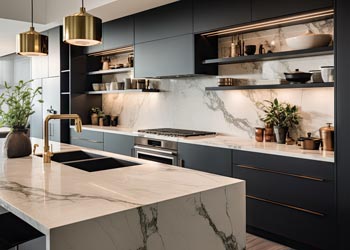
Designing a kitchen involves careful consideration of both layout and floor plan, as they significantly influence functionality, flow, and the overall appeal of the space.
Exploring various options such as galley, L-shaped, U-shaped, and island layouts offers insights into choosing the perfect fit for different kitchen spaces.
Continue reading to learn more about kitchen layouts and floor plans and how these decisions can make or break your home renovation.
Exploring Kitchen Layouts and Floor Plans
Galley Kitchen
A galley kitchen features cabinets and countertops along two parallel walls, creating a narrow walkway between them. Ideal for small to medium-sized kitchens, it ensures efficiency but may pose limitations in larger spaces. Key considerations include:
- Efficiency: Everything is within easy reach, promoting efficient workflow.
- Space Constraints: Limited space may not suit larger kitchens or those requiring extensive storage.
- Traffic Flow: Defined walkways organize traffic, but it may become congested with multiple users.
- Design Tips: To optimize storage and functionality, tall cabinets, pull-out shelves, and light colors create an illusion of openness.
L-Shaped Kitchen Layout
An L-shaped kitchen utilizes cabinets and countertops along two adjacent walls, forming an L configuration. Versatile and suitable for various kitchen sizes, it offers:
- Flexibility: Adaptable to different kitchen dimensions, including open-concept spaces.
- Workflow Efficiency: Provides ample counter space and storage, facilitating smooth workflow.
- Traffic Flow: Well-defined traffic paths enable multiple users to work seamlessly.
- Island Integration: Adding an island enhances workspace and introduces casual dining options.
U-Shaped Kitchen Layout
The U-shaped layout features cabinets and countertops along three adjacent walls, creating a U configuration. Ideal for larger kitchens, it offers:
- Abundant Storage: Extensive storage options and ample countertop space cater to avid cooks.
- Efficient Work Triangle: Optimized layout between stove, refrigerator, and sink streamlines tasks.
- Space Considerations: Requires more square footage, not suitable for compact spaces.
- Island Possibilities: If space permits, integrating an island enhances functionality and seating.
Island Kitchen Layout
Incorporating an island into kitchen design adds versatility, providing additional workspace, storage, and seating options. Key features and considerations include:
- Versatility: Islands complement various layouts, offering extra prep space and gathering spots.
- Traffic Management: Ensure sufficient clearance around the island for easy movement.
- Size and Placement: Careful consideration ensures the island complements the overall design.
- Customization: Islands can include sinks, cooktops, or appliances based on individual needs.
Choosing the Perfect Kitchen Layout
Selecting the ideal layout depends on factors such as kitchen size, cooking preferences, lifestyle, and budget. Consider these tips:
- Assess Space: Measure the kitchen and account for architectural features.
- Prioritize Needs: Determine if maximizing storage, workflow efficiency, or dining areas is essential.
- Traffic Flow: Ensure clear pathways for movement.
- Budget and Space: Balance remodeling costs with available square footage.
- Personalization: Customize layouts to match specific requirements.
Choosing the right kitchen layout is pivotal in creating a functional and visually appealing space. Whether compact or spacious, there's a layout to transform your kitchen into the heart of your home. Reach out to our team of experts to kickstart your kitchen remodeling project.


